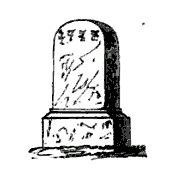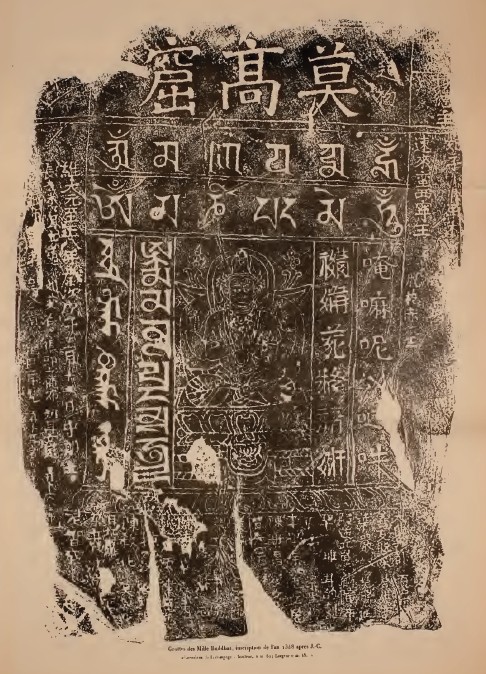|
Tangut Dharani Pillars
The Tangut dharani pillars () are two stone dharani pillars, with the text of a ''dhāraṇī''-sutra inscribed on them in the Tangut script, which were found in Baoding, Hebei, China in 1962. The dharani pillars were erected during the middle of the Ming dynasty, in 1502, and they are the latest known examples of the use of the Tangut script. They are also very rare examples of Tangut monumental inscriptions outside of the territories ruled by the Western Xia dynasty. The only other known example of an inscription in the Tangut script that has been found in north China is on the 14th-century Cloud Platform at Juyongguan in Beijing. These pillars indicate that there was a vibrant Tangut community living in Baoding, far from the Tangut homeland in modern Ningxia and Gansu, during the early 16th century, nearly 300 years after the Western Xia was conquered by the Mongol Empire. History The two pillars were discovered in 1962 in the village of Hanzhuang () in the northern suburbs of ... [...More Info...] [...Related Items...] OR: [Wikipedia] [Google] [Baidu] |
Tangut Dharani Pillars (cropped)
The Tangut dharani pillars () are two stone dharani pillars, with the text of a ''dhāraṇī''-sutra inscribed on them in the Tangut script, which were found in Baoding, Hebei, China in 1962. The dharani pillars were erected during the middle of the Ming dynasty, in 1502, and they are the latest known examples of the use of the Tangut script. They are also very rare examples of Tangut monumental inscriptions outside of the territories ruled by the Western Xia dynasty. The only other known example of an inscription in the Tangut script that has been found in north China is on the 14th-century Cloud Platform at Juyongguan in Beijing. These pillars indicate that there was a vibrant Tangut community living in Baoding, far from the Tangut homeland in modern Ningxia and Gansu, during the early 16th century, nearly 300 years after the Western Xia was conquered by the Mongol Empire. History The two pillars were discovered in 1962 in the village of Hanzhuang () in the northern subur ... [...More Info...] [...Related Items...] OR: [Wikipedia] [Google] [Baidu] |
Shi Jinbo
Shi Jinbo () (born 3 March 1940) is a Chinese linguist and Tangutologist. Biography Shi Jinbo was born in Gaobeidian City, Hebei in 1940. After leaving school, he enrolled at the Central College for Nationalities in Beijing, where he studied the Yi language. During 1960–1961 Shi went to live among impoverished Yi peasants in the Liangshan Yi Autonomous Prefecture of Sichuan in order to improve his language skills, and by the end of his time there he was fluent enough in the Liangshan Yi language to be able to act as an interpreter for a local government committee. He graduated in 1962, and encouraged by Wang Jingru (), his advisor for his Master's degree, who believed that the extinct Tangut language was related to the Yi language, Shi applied to study Tangut language as a postgraduate at the Institute of Ethnology of the Chinese Academy of Social Sciences. After graduating in 1966, Shi joined a team researching the Western Xia caves at the Mogao Caves near Dunhuang in ... [...More Info...] [...Related Items...] OR: [Wikipedia] [Google] [Baidu] |
Yongning Temple Stele
The Yongning Temple Stele () is a stele erected by the Chinese Ming dynasty in 1413 with a trilingual inscription to commemorate the founding of the Yongning Temple (永寧寺) in the Nurgan outpost, near the mouth of the Amur River, by the eunuch Yishiha. The location of the temple is the village of Tyr near Nikolayevsk-on-Amur in Russia. This stele is renowned both as the latest known example of a monumental inscription in the Jurchen script, and also for the inscription of the Buddhist ''mantra'' Om mani padme hum in four different scripts on its sides. A stele with a monolingual Chinese inscription, commemorating the repair of the temple by Yishiha, was erected in 1433. Both monuments are now held at the Arsenyev Museum in Vladivostok. Background The Ming government under the Yongle Emperor (reigned 1402–1424) attempted to expand its influence in the far north and defend itself against the Mongols by setting up a system of guards and posts in the territory of the Haixi J ... [...More Info...] [...Related Items...] OR: [Wikipedia] [Google] [Baidu] |
Om Mani Padme Hum
' ( sa, ॐ मणि पद्मे हूँ, ) is the six-syllabled Sanskrit mantra particularly associated with the four-armed Shadakshari form of Avalokiteshvara, the bodhisattva of compassion. It first appeared in the Mahayana ''Kāraṇḍavyūhasūtra'' where it is also referred to as the ''sadaksara'' (six syllabled) and the ''paramahrdaya'', or “innermost heart” of Avalokiteshvara. In this text the mantra is seen as the condensed form of all Buddhist teachings. The precise meaning and significance of the words remains much discussed by Buddhist scholars. The literal meaning in English has been expressed as "praise to the jewel in the lotus", or as a declarative aspiration possibly meaning "I in the jewel-lotus". ''Padma'' is the Sanskrit for the Indian lotus (''Nelumbo nucifera''), and ''mani'' for "jewel", as in a type of spiritual "jewel" widely referred to in Buddhism. The first word, '' aum/om'', is a sacred syllable in various Indian religions, and ''hum'' ... [...More Info...] [...Related Items...] OR: [Wikipedia] [Google] [Baidu] |
Stele Of Sulaiman
The Stele of Sulaiman is a Yuan Dynasty stele that was erected in 1348 to commemorate the benefactors and donors to a Buddhist temple at the Mogao Caves southeast of Dunhuang in Gansu, China. The principal benefactor is named as Sulaiman (), Prince of Xining (died 1351). The stele, which is now held at the Dunhuang Academy, is renowned for an inscription of the Buddhist ''mantra'' ''Om mani padme hum'' in six different Writing system, scripts. Another stele, commemorating the restoration of the Huangqing Temple () in 1351 by Sulaiman was found at the same location as the 1348 stele. Discovery The two steles were first recorded by the French explorer, Charles Eudes Bonin (1865–1929), during an expedition to western China from 1898 to 1900. When Aurel Stein visited Dunhuang in 1900–1901 he found both steles outside a shrine next to Cave 96, the home of a colossal Buddha statue, 35.5 m in height. Stein supposed that the steles originally belonged in the cave of the colossal Buddha, ... [...More Info...] [...Related Items...] OR: [Wikipedia] [Google] [Baidu] |
Mani Stone
Mani stones are stone plates, rocks or pebbles inscribed with the six-syllabled mantra of Avalokiteshvara (''Om mani padme hum'', hence the name ''mani stone''), as a form of prayer in Tibetan Buddhism. The term mani stone may also be used to refer to stones on which any mantra or devotional designs (such as ashtamangala) are inscribed or painted. Mani stones are intentionally placed along the roadsides and rivers or grouped together to form mounds or cairns or sometimes long walls, as an offering to spirits of place or '' genius loci''. Creating and carving mani stones as devotional or intentional process art is a traditional sadhana of piety to yidam. Mani stones are a form of devotional cintamani. The preferred technique is sunk relief, where an area around each letter is carved out, leaving the letters at the original surface level, now higher than the background. The stones are often painted in symbolic colours for each syllable (''om'' white, ''ma'' green, ''ni'' ye ... [...More Info...] [...Related Items...] OR: [Wikipedia] [Google] [Baidu] |
Chinese Characters
Chinese characters () are logograms developed for the writing of Chinese. In addition, they have been adapted to write other East Asian languages, and remain a key component of the Japanese writing system where they are known as ''kanji''. Chinese characters in South Korea, which are known as ''hanja'', retain significant use in Korean academia to study its documents, history, literature and records. Vietnam once used the '' chữ Hán'' and developed chữ Nôm to write Vietnamese before turning to a romanized alphabet. Chinese characters are the oldest continuously used system of writing in the world. By virtue of their widespread current use throughout East Asia and Southeast Asia, as well as their profound historic use throughout the Sinosphere, Chinese characters are among the most widely adopted writing systems in the world by number of users. The total number of Chinese characters ever to appear in a dictionary is in the tens of thousands, though most are graphic ... [...More Info...] [...Related Items...] OR: [Wikipedia] [Google] [Baidu] |
Old Uyghur Alphabet
The Old Uyghur alphabet was a Turkic script used for writing the Old Uyghur, a variety of Old Turkic spoken in Turpan and Gansu that is the ancestor of the modern Western Yugur language. The term "Old Uyghur" used for this alphabet is misleading because Qocho, the Uyghur (Yugur) kingdom created in 843, originally used the Old Turkic alphabet. The Uyghur adopted this "Old Uyghur" script from local inhabitants when they migrated into Turfan after 840. It was an adaptation of the Aramaic alphabet used for texts with Buddhist, Manichaean and Christian content for 700–800 years in Turpan. The last known manuscripts are dated to the 18th century. This was the prototype for the Mongolian and Manchu alphabets. The Old Uyghur alphabet was brought to Mongolia by Tata-tonga. The Old Uyghur script was used between the 8th and 17th centuries primarily in the Tarim Basin of Central Asia, located in present-day Xinjiang Uygur Autonomous Region, China. It is a cursive-joining alphabet with ... [...More Info...] [...Related Items...] OR: [Wikipedia] [Google] [Baidu] |
Tibetan Alphabet
The Tibetan script is a segmental writing system (''abugida'') of Indic origin used to write certain Tibetic languages, including Tibetan, Dzongkha, Sikkimese, Ladakhi, Jirel and Balti. It has also been used for some non-Tibetic languages in close cultural contact with Tibet, such as Thakali. The printed form is called uchen script while the hand-written cursive form used in everyday writing is called umê script. This writing system is used across the Himalayas, and Tibet. The script is closely linked to a broad ethnic Tibetan identity, spanning across areas in India, Nepal, Bhutan and Tibet. The Tibetan script is of Brahmic origin from the Gupta script and is ancestral to scripts such as Meitei, Lepcha,Daniels, Peter T. and William Bright. ''The World's Writing Systems''. New York: Oxford University Press, 1996. Marchen and the multilingual ʼPhags-pa script. History According to Tibetan historiography, the Tibetan script was introduced by Thonmi Sambhota in the firs ... [...More Info...] [...Related Items...] OR: [Wikipedia] [Google] [Baidu] |
Lanydza Script
The Rañjanā script (Lantsa) is an abugida writing system which developed in the 11th centuryJwajalapa and until the mid-20th century was used in an area from Nepal to Tibet by the , the historic inhabitants of the , to write and . Nowadays it is also used in Buddhist monasteries in India; |
Usnisa Vijaya Dharani Sutra
The ushnisha (, IAST: ) is a three-dimensional oval at the top of the head of the Buddha. In Pali scriptures, it is the crown of Lord Buddha, the symbol of his Enlightenment and Enthronement. Description The Ushnisha is the thirty-second of the 32 major marks of the Buddha. The thirty-second of these is that the Buddha has a fleshy or cranial protuberance at the top of his head. Later sets elaborate that this is covered with hairs that curl in the direction of the sun. Later on a second definition of Ushnisha was added, which was a flame that ascends from the middle of this protuberance. Representation The first representations of the Buddha in the 1st century CE in the Greco-Buddhist art of Gandhara also represent him with a topknot, rather than just a cranial knob. It is thought that the interpretation of the ushnisha as a supernatural cranial protuberance happened at a later date, as the representation of the topknot became more symbolic and its original meaning was lo ... [...More Info...] [...Related Items...] OR: [Wikipedia] [Google] [Baidu] |
.jpg)





